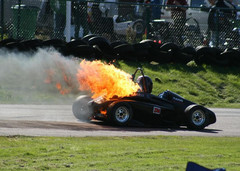As we enter a new season of Formula Student competition, it is probably a good idea to talk about safety. Yeah, I know you guys are invincible, can stop bullets with your teeth and are totally impervious to injury. Truth is, accidents do happen and people do get hurt.
The organisers of these events have a ‘duty of care’ in law to avoid, where possible, injury to any participant at any competition, hence the plethora of safety rules. How do the rule makers calculate the risks?
Well, Risk Assessors use the formula Risk = Hs x Hp, where Hs is the severity of the hazard and Hp is the probability of the hazard. Hazards can be categorised by the aggregate probability of the occurrence of the individual conditions that make up the hazard and by the seriousness of the effects of the resulting mishaps. Together these constitute risk.
So, how the heck do the FS rule makers work that out? Simply stated, they don’t! Rather, they rely on experience and common sense (as well as a healthy fear of lawyers) to come up with a set of rules to ensure a reasonably safe event. These include the rules on structure and required personal safety equipment. It also covers the layout of the course, where speeds are deliberately kept low (remember F = MA) so impacts that may occur are minimised.
What this column is about is YOUR responsibility in keeping safe!
Experience has shown us that catastrophic collisions don’t usually happen in FS, and that the most serious kind of accident a team may face is fire. That doesn’t mean we can ignore the ‘catastrophic collision’ scenario. Remember last month I discussed flexible wheels for the second time in a few months? A wheel or suspension that breaks under a high ‘G’ load can pitch a car into a roll. The team needs to think about this possibility when designing wheels and suspension components. Why do you think the Judges hate incorrectly used rod ends? It’s not because we are being miserable. It’s because we have seen what can happen when these things break! As our cars get more sophisticated, as the ‘G’ loadings get higher, so the chance of this type of failure increases.
All of this should be taken into account if you envisage running your car in speed events such as hill climbs or sprints. These events are run at much higher speeds, so the ‘G’ loads are higher. Generally the scenery at these events is much less forgiving. There is a big difference between having a suspension failure and rolling on an open car park, and having the same failure causing you to spear off into a bank or Armco fence… or worse, a post or a tree! That is why the FS and FSAE organisers actively dissuade teams competing in these events. A serious crash in one of our cars could have a dramatic effect on our competition.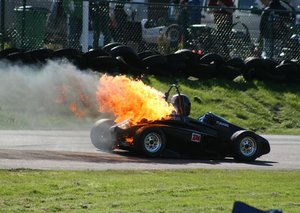
Helsinki 2007 fire.
Pic from Stadia Engineering site
As mentioned earlier, fire is a more likely accident, so we do our best to avoid this becoming an issue. Rules regarding fire extinguishers, firewalls, fire suits etc are part of the organiser’s efforts to address the fire risk, yet cars still catch fire! That is why we have a 5 second egress rule. If you can get out of the car in 5 seconds at technical inspection, you will egress in 2 seconds if the car is on fire!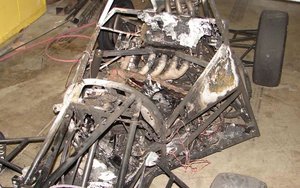
Result of Uni of Alabama 2007 fire.
Pic from Uni of Alabama FSAE team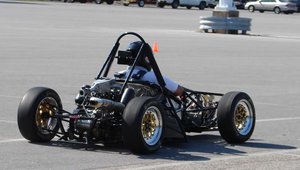
Driving the Alabama car before the fire. Note the driver’s apparel!
Pic from Uni of Alabama FSAE team
Accepting that fire may happen, it is the team members’ responsibility to minimise their own risk of injury. The rules require minimum standards of fire suits, i.e. SFI 3-2A/1 minimum. This SFI standard has a ‘Thermal Protective Performance’ of 6, offering 3 seconds of protection from second degree burns under certain conditions! Would I wear a 3-2A/1 suit in competition? No way, at least not without additional layers of protection. Higher levels of SFI suits are available and I would be looking at a 3-2A/5 standard as a minimum.
Monash 2003 fire
Burns in race cars are more likely to be from radiant heat rather than direct flame, but a failure of the fuel tank could easily have the driver sitting in a pool of fire. This possibility should have the team considering all their protective equipment, not just that mandated in the rules. Layering clothing under the suit is the best way to improve the performance of the suit against radiant heat. Choosing a loose fitting suit (within reason) is a good idea as this permits more air space between the suit and the wearer, thereby increasing insulation
Nylon quickly melts into globules that adhere to the skin, so nylon attire under a race suit should be avoided. Cotton or wool is a better alternative. Woollen socks are a good idea. The rules prohibit the use of leather gloves for a good reason, leather is a poor insulator. You should use proper Nomex driving gloves, not the karting look-alikes that are legal but offer little protection in the case of fire.
Helmets are another issue. Although the rules permit motorcycle helmets, and these helmets are arguably more suitable than racing helmets for our competition, these helmets are invariably nylon lined. If you wear a motorcycle helmet, I would strongly advise the use of a nomex balaclava to keep molten nylon away from skin, and should be tucked into the suit. A balaclava is required for long hair or a beard, but is a good idea in any case.
Your racing suit should NOT be worn when working on the car! Any grease, oil, cleaning fluids etc on the suit will reduce the performance of the suit. The oil burns and the suit material acts as a wick. Soiled suits should be cleaned according to the maker’s instructions. The driver should also be kept dry. A wet suit can cause steam burns or scalding to the driver in the event of fire. Here is another reason for a team to have ‘brolly girls’. I know it’s a pain to keep climbing in and out of a race suit, so that’s another reason for choosing a suit with a relaxed fit.
The harness is specified in the rules and I have occasionally been asked why crutch straps must be worn even in cars with an upright seating position. Crutch straps do more than prevent the driver from ‘submarining’ down into the car on a frontal crash (this contributed to the fatal injuries suffered by the Austrian F1 Champion Jochen Rindt). The forward movement of a driver in a crash causes the shoulder straps to pull the lap belt up from across the driver’s pelvis and over his abdomen. Crutch straps prevent this from occurring. Many years ago a friend had this happen, rupturing his bladder. He nearly died and there is another lesson here… don’t compete with a full bladder! Mother Nature causes the ‘nervous piddles’ for a good reason!
The harness should be removed from the car, or at the very least carefully protected, when working on the car. The same warning about soiling on the suit holds double for the harness webbing. Most webbing is made from Nylon 66. While this material is very suitable for belts, it will make a good wick and burn if it is impregnated with oil or grease.
Hopefully this article and the attached pictures will have teams consider their responsibilities in event safety. The rule makers and technical inspectors can only do their best, the real responsibility lies with the team members themselves!
Until next time, good luck to all teams in their preparations for the upcoming events.
Pat

Pat’s Error of the Month.
Make sure you read the rules and buy the appropriate equipment. A few years ago a team turned up with every driver sporting a new driving suit that met this standard.
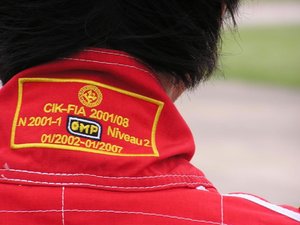
CIK-FIA standard is for karting suits. These suits were immediately rejected at technical inspection, leaving the team several thousands of dollars out of pocket. Read the rules!

